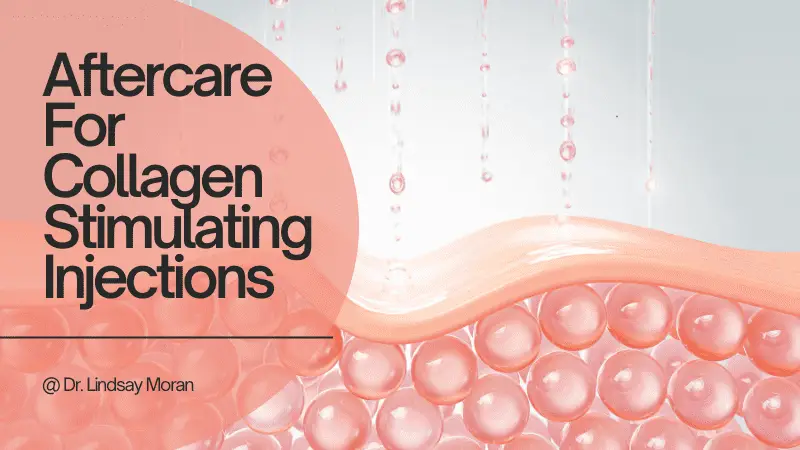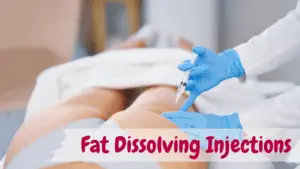Below I have detailed the aftercare information so that you can be aware of potential side effects, and to ensure you get the best possible outcomes by speeding up the healing process and reduce the risk of complications.
Collagen-stimulating injections, also known as collagen induction therapy, is a non-surgical cosmetic procedure aimed at enhancing your skin’s natural beauty by encouraging the production of collagen which gives our skin firmness, strength, and elasticity.
Early side effects
Collagen-stimulating injections are generally safe, but as with any cosmetic procedure, there can be some temporary early side effects.
Here are some of the common early side effects you may experience:
- Swelling: Some degree of swelling is to be expected after the procedure, especially in the first 24 to 48 hours. This is a normal part of the body’s healing process.
- Redness: The treated area may become red, which is also a normal response to the injections.
- Bruising: Depending on the injection site and your body’s response, you might experience some bruising. This should fade within a week.
- Tenderness and discomfort: The treated area may feel tender or slightly uncomfortable for a few days following the procedure.
- Itching: Some patients may experience itching at the injection site, which should also resolve on its own.
- Bumps or lumps: Occasionally, small bumps or lumps may form under the skin at the injection site. These usually disappear over time as the product settles and your skin starts producing collagen.
These side effects are generally temporary and should resolve within a week. If you experience severe pain, heavy swelling, or any other unusual symptoms not mentioned here, you should contact me immediately.
Delayed side effects
Delayed side effects from collagen-stimulating injections are rare but can occur. If they do, it’s usually within a few weeks to a few months after treatment.
Here are some potential delayed side effects:
- Delayed Swelling or Bruising: Although most swelling and bruising resolve within a week or so, in rare cases, they can persist longer.
- Nodule Formation: Small, hard lumps, or nodules, can sometimes form under the skin at the treatment site. These can develop weeks or even months after the procedure. Most are benign and resolve with time or simple interventions.
- Infection: While rare, there’s always a risk of infection with any injectable treatment. Signs of infection may include severe pain, pus, warmth, and fever.
- Allergic Reactions: Though very rare, some individuals may experience allergic reactions to the ingredients in the injections like rash, hives, difficulty breathing, and swelling of the face, lips, tongue, or throat.
- Skin Discoloration: Some patients may experience changes in skin color (hyperpigmentation or hypopigmentation) at the injection site.
- Granulomas: Rarely, granulomas or inflammatory lumps may form at the treatment site. This immune system reaction can occur months after the injections.
Care in the first 24-48 hours after treatment
Here’s a detailed guide on how to take care of the treated area in the first 24-48 hours after receiving collagen-stimulating injections:
- Ice Application: Applying an ice pack wrapped in a thin cloth to the treated area for 15 minutes at a time, every 2-3 hours can help manage any initial swelling or bruising.
- Avoid Touching or Massaging the Area: Refrain from touching, massaging, or applying pressure to the treated area for at least 6 hours following treatment. This will help prevent unwanted migration of the product.
- Avoid Intense Heat: Activities that result in excessive heat exposure like saunas, hot tubs, sunbathing, and tanning beds should be avoided for a minimum of 48 hours post-treatment.
- Limit Physical Activity: To minimize the risk of swelling, it is advisable to avoid strenuous exercise or heavy physical activity for at least 24 hours after treatment.
- Avoid Alcohol and Blood Thinners: It is recommended to avoid alcohol and any blood-thinning medications or supplements (like aspirin, ibuprofen, or vitamin E) for at least 24 hours before and after treatment. These can increase the risk of bruising or swelling.
- Hydrate: Drink plenty of water post-treatment. Staying well-hydrated can help your body process the injections and maintain skin hydration.
- Skin Care: Stick to your normal skincare routine, but avoid using any harsh scrubs or products containing retinol for at least 48 hours after treatment. These products can irritate the skin and interfere with the healing process.
What to do if you get side effects?
- For minor side effects and discomfort, you can use massage, ibuprofen, antihistamines (ie Zyrtec) and ice packs.
- If you have any concerns or if your side effects persist longer than expected (for example, if swelling or bruising does not reduce after a week), contact me immediately.
When will you start to see results?
Generally, you may start noticing initial improvements in your skin quality and texture within a few weeks after the procedure.
However, the full effects typically become apparent after 2-3 months, when your body has had ample time to produce new collagen.
The results can vary from person to person, depending on factors such as the individual’s skin type, age, lifestyle, and the area being treated.
Some people might require multiple treatment sessions to achieve their desired results.
Next Steps
Follow up Appointment
- Get scheduled a follow-up appointment around 2-4 weeks after your treatment to assess how well you’re healing and how your skin is responding to the treatment.
- Make sure to attend this appointment and any subsequent appointments scheduled by us.
Skincare
- Keep your skin clean and well-hydrated. Use a gentle cleanser and a good quality moisturizer.
- Avoid using any harsh scrubs or products containing retinol for at least 48 hours after treatment.
- Protect your skin from excessive sun exposure. Use a broad-spectrum sunscreen with an SPF of at least 30 every day, even on cloudy days.
- Remember to drink plenty of water.
- Once any initial redness and sensitivity have subsided, you may resume using retinol products if they’re part of your usual skincare regimen.
- Antioxidants like vitamin C can also be beneficial to protect the skin and boost collagen production.
Factors affecting treatment duration
Several factors can influence the duration of collagen-stimulating treatment and the time it takes to see noticeable results.
These factors include:
- Treatment Area: Larger areas may require more injections or multiple treatment sessions, which can extend the overall treatment time.
- Treatment Protocol: Some protocols involve a series of injections spaced out over several weeks or months, while others may involve a single treatment session.
- Product Used: Different collagen-stimulating products have varying mechanisms of action and properties. Some products require multiple sessions over a longer period to achieve optimal results, while others may produce noticeable improvements with fewer treatment sessions.
- Individual Response: Each person’s body responds differently to collagen-stimulating injections. Factors such as age, overall health, skin type, and the body’s natural collagen production ability can influence how quickly results are visible. Some individuals may experience faster collagen production and quicker results compared to others.
- Treatment Goals: The extent of your desired results can impact the duration of treatment. If you have significant skin concerns or wish to achieve more dramatic improvements, it may require more treatment sessions or additional treatments over time.
- Collagen Maturation Time: Collagen production stimulated by the injections takes time to mature and fully manifest. While you may notice initial improvements in skin quality, it typically takes several weeks to months for the full effects to become apparent.
Treatment recommendations to compliment your therapy
To complement collagen-stimulating therapy and enhance its effectiveness, there are several treatment recommendations you can consider:
- Chemical Peels: Chemical peels can improve skin texture, tone, and stimulate collagen production.
- Microdermabrasion: This treatment exfoliates the skin, improving its texture and promoting cell turnover.
- Microneedling: Microneedling treatments create tiny controlled injuries in the skin, stimulating collagen production and improving skin texture and firmness.
- Laser or Light Therapy: These treatments can target specific skin concerns, such as pigmentation issues, redness, or fine lines, and may also promote collagen synthesis.
- Dermal Fillers: Depending on your specific goals, your healthcare provider may recommend combining collagen-stimulating injections with dermal fillers. Dermal fillers can help restore volume, plumpness, and smooth out deeper lines and wrinkles.
- Skin-Boosting Nutrients: Consider incorporating collagen-boosting nutrients into your diet or as supplements. These include foods rich in vitamin C, antioxidants, and amino acids that support collagen synthesis.
How to maximize your results
To maximize your results with collagen-stimulating therapy:
- Follow the recommended treatment plan and be consistent.
- Practice good skincare, including cleansing, moisturizing, and daily sunscreen use.
- Protect your skin from excessive sun exposure.
- Adopt a healthy lifestyle with a balanced diet, regular exercise, and stress management.
- Stay hydrated by drinking plenty of water.
- Consider nutritional support with foods rich in collagen-supporting nutrients.
- Avoid smoking and limit alcohol consumption.
- Manage stress through relaxation techniques.
- Attend regular follow-up appointments.
Frequency of Treatment
The frequency of collagen-stimulating treatment sessions can vary depending on several factors, including the specific treatment protocol, individual response to the treatment, and desired results.
Generally, collagen-stimulating treatments are performed in a series of sessions scheduled over a specific period.
Common treatment frequencies include:
- Initial Series: A typical initial series may consist of 3-4 treatment sessions spaced about 4-6 weeks apart. This allows sufficient time for the body to respond and stimulate collagen production.
- Maintenance Sessions: After completing the initial series, maintenance sessions are often recommended to sustain the results. Maintenance treatments can range from once every 3-6 months to once every 1-2 years, depending on individual needs and the specific treatment used.
When to get in contact
If you have any concerns, are worried about severe side effects, or you don’t like how the treatment worked, please get in touch right away.
Contact phone: 0405537602
Email: [email protected]
If you notice that the effects are severe than expected, then please get in touch.
I hope this covers everything you need. Please get in touch if you want to know anything else.
If you liked your treatment, it would be great if you could write a nice review for me on Google.




